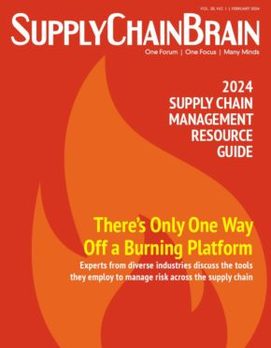
Home » Logistics Providers Adapt Services To Shifting Demand
Logistics Providers Adapt Services To Shifting Demand
July 1, 2006
Walk into a special section at an Ozburn-Hessey Logistics center and you may think you've somehow stumbled into someone's living room. In fact, you would have walked into a professional photography studio operated by OHL on behalf of a large internet retailer of home goods. When new products for this customer arrive at the logistics center, they are positioned, lighted and shot by a commercial photographer for the retailer's online catalog. Digital images then are uploaded directly to the client's marketing department.
"We are the first people to see this customer's goods as they come in from an offshore manufacturer," says David Gordon, executive vice president of Nashville-based OHL. "We uncrate them and a trained photographer does the creative work." The in-warehouse studio includes several different rooms "that are pretty much like a film set," he says.
Shift to a distribution center managed by Seko Worldwide, Chicago, and the scene might be of white-coated technicians working on sophisticated medical equipment. The equipment, owned by Philips Medical Systems, is housed at several Seko DCs, where Philips' trained technicians come in to inspect and maintain it between short demonstrations at hospitals and clinics. Seko also arranges the delivery and return of the equipment to and from demonstration sites. "Typically we will warehouse three to five units at smaller depots; some larger depots may have 20 to 40 units," says Kelly Knight of Seko's Baltimore, Md., facility. "We not only provide typical warehousing, we also provide the clean room space that Philips' technicians need to work on the equipment."
These examples of value-added services are indicative of an ongoing trend by 3PLs to expand their offerings well beyond traditional warehousing and transportation.
"There is a constant push for 3PLS to offer services that will differentiate them in the market, because otherwise they will become a commodity, subject to continual downward price pressure," says Brooks Bentz, a partner in Accenture's Supply Chain Management practice, based in Boston. "Value-added services allow them to make a little extra money by offering something different," he says.
The definition of "value-added" can be a moving target, however. Many services that used to fall into that category-things like kitting, sequencing and repackaging - have become more or less embedded in standard warehouse offerings, says Joe Gallick, senior vice president of sales at Penske Logistics, Reading, Pa. "A lot of value-add services that are emerging today are outside the boundaries of activities we have done in the past," he says.
Many of these newer value-added activities are driven by globalization of supply chains.
"Globalization has made supply chains much more complex and difficult to manage, says Bentz. "A manufacturer may have five component suppliers offshore and have to bring all that stuff together, assemble it at a regional hub, ship it across the pond, do all the customs and cross-border work and then all the domestic distribution activities. Having an integrated solution with end-to-end visibility and a single provider is very attractive to a lot of companies that don't have the human capital and technology to do it themselves."
Customers looking for end-to-end global solutions pushed the international side of Menlo Worldwide's business up 53 percent last year, says Bob Bianco, president of the Redwood City, Calif.-based company. As a result, he says, Menlo "is spending a lot of resources building out our international capabilities."
One Face to the Customer
One role that customers increasingly ask Menlo to play is that of global forwarder manager, says Bianco. "For years we have been managing inland transportation, but now more and more customers are asking us to manage forwarders on intercontinental moves in order to get that end-to-end control," he says. Menlo's forwarder solution follows its proven transportation management model, he says. "We take the requirements of each customer-volumes by lane and product flows-then with our understanding of the strengths and weaknesses of different forwarders, we bid out the business and put together a solution using multiple forwarders across the world."
During shipment execution, Menlo aggregates information feeds from each of the forwarders to provide full visibility to the customer. "It is much easier for our client to go to one point of contact for this information than to try and manage the many different parties that make up the supply chain," he says. "This approach also meets customers' demands for a consistent approach, consistent systems and consistent performance wherever they operate."
DHL Solutions, Plantation, Fla., also underscores this point. "Customers definitely are looking for fairly consistent service and quality across the globe, which is something that not many providers can offer," says Rolf Habben Jansen, DHL's managing director for global business development. "We believe it is an advantage to us to be able to provide one face to the customer in the many parts of the globe where we operate."
Scott Szwast, marketing manager at UPS Supply Chain Solutions, Atlanta, puts it more bluntly. "Customers like to have 'one throat to choke,'" he says. "One of the great truths of supply chain management is that if bad things happen, they tend to happen at transition points. There are a lot of transition points in a global supply chain, which is why you inevitably see a lot of finger pointing when something goes wrong. The beauty of integrators like UPS is that we provide that single source of accountability."
| "We do a whole host of services around vendor performance." -Tony Zasimovich of APL Logistics | |
Since many offshore vendors still are not EDI capable, a key service continues to be EDI compliance, he says. "We have a suite of products and services called Advanced Shipping Notice (ASN) Tool Kit, which ensures that detailed information on shipments gets to our customers timely and accurately so that they can go ahead and allocate against it. Then when the shipment arrives, it can be processed through a cross-dock and sent immediately out, saving considerable time."
Shaving days or even weeks off the long lead times typically associated with global supply lines adds tremendous value. With its TradeDirect solution, UPS SCS has helped customers like Winbrella slice 10 to 15 days out of the supply chain. Winbrella's canopy umbrellas, which are manufactured in Asia, are packaged and labeled for direct shipment to customers before being loaded into an ocean container. At the ship's first U.S. port call, the container is unloaded and the packages immediately fed into the UPS small package network. "Winbrella was able to disintermediate that entire step of unloading the goods and sending them to a distribution facility for processing," says Phil Corwin, director of marketing at UPS SCS. "As a relatively small business, they have said that this enables them to compete with much larger companies."
To help its customers better manage their global supply chains, DSC Logistics, Des Plaines, Ill., is finding new value in an old solution-foreign trade zones. DSC recently opened a million-square-foot facility with FTZ designation south of Chicago, adjacent to a new BNSF rail yard. FTZs are areas where companies can store and add value to imported products. U.S. duties are deferred until the product moves into local commerce and can be eliminated altogether if the product is exported to another country.
One of the value-added services that DSC performs in the FTZ is kitting or combining several imported components into a single product that is then delivered to a retailer. "For example, we make home theater kits by combining the LCD panel, the speakers and the other parts that all come in separately," says Scott Morgan, vice president of customer care at DSC. "Our customer then pays duties on the finished package instead of the individual components, which in many cases means they are paying less."
Risk Management
Another aspect of global supply chains where 3PLs are adding value is area of security and risk management. "With the many policy changes and regulatory changes, I think security will require ongoing and long-term skills building, which many companies will want to outsource," says Bentz. "I just don't think business people have the stomach to make the long-term investments to build those skills if they don't already have them." Should there be another 9/11 type incident, he says, "security regulations will change radically and companies will find it difficult to manage that all by themselves."
But it is not just terror threats that concern companies, says Zasimovich. "Just look at the last couple of years and the floods and tsunamis and hurricanes and earthquakes that have occurred. Business contingency planning for all these types of disruptions is a big issue with companies and they want us to be able to respond quickly." APL Logistics, for example, recently put together a plan for dealing with avian flu, should an epidemic occur. "Our customers are concerned about this so we put together a plan. It goes down to small details such as making sure warehouses have netting to keep birds from under the eaves and making sure cargo is protected from droppings," he says.
Customers are asking for both business continuation planning and disaster recovery planning, says Gordon. In response, OHL has established a back-up technology site in a remote area of Tennessee "that has no history of natural disasters." OHL also provides personnel redundancy with a core group of generalists prepared to move quickly to different customer accounts. "We had a customer whose operations were wiped out last year in Miami by a hurricane, and we were able to instantly shift the customers served from that location to another of our client's facilities to keep product flowing," he says. "We use our transportation expertise to find carriers to serve these new distribution points."
Mitigating financial risk also is becoming an issue for 3PLs, though not always by choice. "As a key partner in our customers' supply chain, we are having to take some responsibility for helping them make sure they are making accurate representations under Sarbanes-Oxley legislation," says Gallick. "Our outsourcing engagements are more and more mandating that that we comply with Sarbanes-Oxley requirements and that we be open to accounting audits that are dictated by those mandates."
Cornering Capacity
Another market force driving companies to third-party logistics providers is the shortage of transportation capacity. "In 2004 capacity became king," says Todd Ericksrud, vice president, customer and provider services, at Schneider Logistics, Green Bay, Wis. As carriers gained more leverage, "our customers began looking for more help in analyzing their transportation spend," he says. Many needed to understand how they could make themselves more attractive to carriers in terms of doing business and also needed to broaden their perspective on which carriers they would use, he says. "I think just the ability to provide that assistance has pushed up the value of the entire 3PL industry in the last couple of years. When a company goes through the bid process, it no longer is always about lowering cost. Sometimes it is about just getting capacity and our having commitments from carriers becomes an incredible value to the customer."
Transplace, Plano, Texas, is finding additional capacity for its customers by tapping into private fleets. "A number of private fleets use our transportation management technology as well as other services and we often find that they have some amount of empty capacity that we are able to schedule," says George Abernathy, executive vice president. One of these companies, he adds, "is now our largest carrier. They have high quality equipment, experienced drivers and great service so this relationship has paid dividends tenfold."
The rise in the cost of fuel and increases in fuel surcharges have reinforced the need for good carrier relationships. "There is no question that companies that have a fuel surcharge program designed to keep carriers whole are the ones getting capacity," says Ericksrud. "One thing that we have been able to do is to standardize that process, so when a customer looks across their carrier base they can have a single fuel surcharge program and be able to compare apples to apples."
National Logistics Management, Detroit, also stresses the importance of having a fuel surcharge program that fairly rewards the carrier base. "We have done that with an automated, methodical process," says Jim Applegate, president of supply chain solutions at NLM. "We don't use a flat percentage that is revisited every six months. We adjust the fuel surcharge on a weekly basis based on a government-issued pricing benchmark." Keeping carriers in NLM's program "is probably the best use of our time right now," he says. "Offering a fair fuel surcharge is one way to do that." NLM specializes in urgent, premium freight shipments.
CaseStack, Santa Monica, Calif., has taken a different approach, rewarding drivers that agree to use a certain percentage of bio-diesel fuel. "Our ultimate goal is to try and get the carriers to start doing this as well," says CEO Dan Sanker. "I think everyone is realizing we have to do something. It wouldn't be bad if that something also happened to be a sustainable green initiative."
Consolidation Twist
CaseStack also participates in one of the newer twists on freight consolidation, a program that is a collaboration with Wal-Mart and several Wal-Mart vendors that are CaseStack clients. Wal-Mart consolidates its orders from these vendors and pre-configures them into truckloads before submitting the orders to CaseStack.
"We also do this type of consolidation ourselves, but this is a really good program," says Sanker. "It is a way to reduce costs without reducing other peoples' margins or service levels. It's one of those rare things where there is no real down side."
The retailer-driven consolidation program also has prompted CaseStack to develop another service for its mid-market clients in the area of demand management. "When a retailer like Wal-Mart orders these nice, solid consolidated loads, if one of those clients doesn't have product in stock with us it creates a problem for all of the others," he says. "We will ship the load, but instead of it being a 40,000-pound truck, we will be shipping a 32,000-pound truck. So it behooves us to try and help our clients manage their inventory positions."
Over time, he says, CaseStack has built "some pretty good demand planning tools" to help clients figure out how much product to stock in each warehouse. "We help them improve their in-stock position and also avoid overstocks, so they reduce their overall inventory and increase their turns, which is good for them and for us."
3PLs, in general, are using technology to add value for customers in many areas. One of their biggest advantages, says Gallick, is in being able to integrate all the different parties and systems in the supply chain. "I think skills in IT integration are as important today as any new or emerging technology," he says.
The need for integration has increased opportunities for engagements as a lead logistics provider, he says. In one such project, Penske is providing all logistics services for the European operations of Eaton, a manufacturer of industrial and automotive components. "The big challenge for us is to integrate the technology of basically 45 individual manufacturing plants," he says. "Some may have been part of the Eaton organization for many years and others are more recent acquisitions. So using our skills and the technology we have in place, as well as creating new middleware applications, we have to enable visibility to all of Eaton's flows throughout Europe. Then, of course, we need to be able to optimize those flows and take costs out of the network and provide more efficiency. So the real technology requirement of an LLP is to be able pull everything together in one seamless, integrated network."
Providing robust, easy-to-use transportation management and order management systems over the Web has transformed the way Transplace works with many of its clients. "We are seeing customers choose to do more on their own behalf using the technology that we provide," says Abernathy. They save money by using the software themselves, he says, without losing the other parts of what a traditional 3PL partnership brings: dependable carrier relationships, access to best practices and performance metrics and reporting. "Customers are pushing toward a minimization of people that we put on an account, and the technology has allowed us to do that."
For example, Transplace has only six employees assigned to U.S. Gypsum-a customer for which it handles more than half a million shipments annually. "This low head count is because U.S. Gypsum uses our system to do much of the work before calling us in," Abernathy says. Pep Boys, a new customer, recently selected Transplace's systems to manage inbound transportation from domestic vendors to its distribution centers and cross-docks. "In about three and a half months, Pep Boys will be on its own typing on the keyboard with no Transplace assistance other than traditional customer support," he says. This doesn't mean a loss of revenue for Transplace, however. "We are different from a traditional 3PL in that as we push our head count and top-line revenue down on a particular account, we push more through the technology, so we make our margin there," Abernathy says. The optimal blend, he says, is to use the technology as much as possible, "supplemented with our services and personnel."
Parts Management
Another huge area for value-added logistics is in parts management, especially for service agreements and warranty compliance. "This is an area that can actually drive top-line sales for a company," says Coriwn of UPS SCS. "Our customers are realizing that the effective use of logistics as part of after-sales service can make their product more attractive and actually create new revenue streams."
In one UPS example, a laptop manufacturer operating in Europe experienced above normal returns of memory and micro chips. Working with the OEM and the chip vendor UPS SCS established a testing facility within the returns center to test returned components. In 60 percent of the cases, no defect was found and these chips could be put right back into inventory. "This is an example of what we see as a growing trend-partnerships where we, the OEM and vendors all work together to benefit the customer. For the OEM, the benefit was a much higher level of inventory availability, which in the service parts world is critical to meeting the requirements of their customers' service level agreements.
This also is an area where lead logistics providers are in demand. Unisys recently selected DHL to manage all of its global service parts logistics and distribution, charging it to consolidate more than 100 service providers into a "comprehensive logistics solution."
"With thousands of service requests per day from our clients around the world, it was imperative for Unisys to streamline our service logistics process through a reliable provider with a strong global network," says Tom Sunseri, vice president and general manager, Service Supply Chain Operations, Unisys.
Fidelitone, Chicago, is one of the nation's largest service parts logistics specialists, supporting more than 1,000 well-known consumer brands and more than 120,000 individual products. "If you break the glass tray in your Microwave or lose your television remote control, we are probably the company that will send out a replacement, on behalf of our client," says Tom Giovingo, executive vice president. Working with retailers like Sears and Best Buy and manufacturers like Weber and Black and Decker, Fidelitone provides database management, inventory forecasting, purchasing and distribution for repair parts and accessories.
"We maintain a database of more than seven million entries," says Giovingo. "If someone bought a Weber grill in 1999 and needs a part today, we have to be able to readily locate in our database the right part, its availability and today's price."
Fidelitone's solutions all are customized, he adds. "We don't handle the Best Buy order management or reverse flow in the same way we handle the Sears business. Each customer has its own unique requirements." That is reflected in the variety of products Fidelitone stores and ships. "It ranges from a single two-ounce screw or a fragile light bulb to 100-pound chest freezers and 200-pound air compressors," says Giovingo.
Choice Logistics, New York City, also specializes in service parts and reverse logistics for clients in the high-tech industry. For Hitachi Data Systems, for example, Choice manages more than 50 unique stocking locations and some 36,000 SKUs for thousands of customers.
"This is a real revenue stream for HDS," says John Miller, vice president of business development. "Instead of having to establish a beachhead in every geographic market, we can provide service wherever they need it. We have consistently been able to provide HDS 99 percent on-time performance and at least a 99.9 percent inventory accuracy level."
RELATED CONTENT
RELATED VIDEOS
KEYWORDS All Warehouse Services Inventory Planning/ Optimization Logistics Logistics Outsourcing Service Parts Management Transportation & Distribution
Related Directories
Subscribe to our Daily Newsletter!
Timely, incisive articles delivered directly to your inbox.
Popular Stories

2024 Supply Chain Management Resource Guide: There's Only One Way Off a Burning Platform
VIEW THE LATEST ISSUECase Studies
-
Recycled Tagging Fasteners: Small Changes Make a Big Impact
-

Enhancing High-Value Electronics Shipment Security with Tive's Real-Time Tracking
-

Moving Robots Site-to-Site
-
JLL Finds Perfect Warehouse Location, Leading to $15M Grant for Startup
-
Robots Speed Fulfillment to Help Apparel Company Scale for Growth



